#King Wenceslaus IV of Bohemia
Text
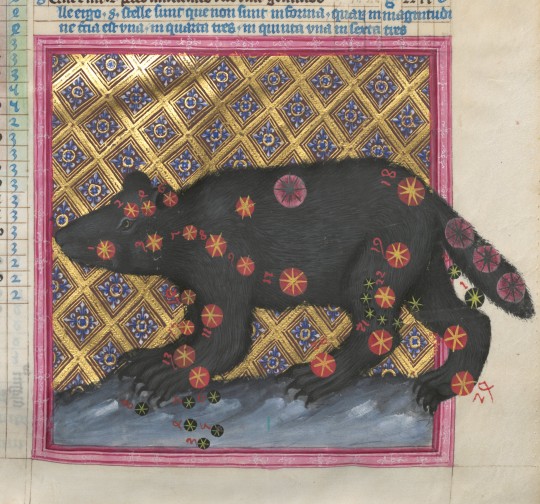
ursa major
in the astronomical-astrological codex for king wenceslaus iv. of bohemia, prague, shortly after 1400
source: Munich, BSB, Clm 826, fol. 34v
#15th century#astronomy#Wenceslaus IV of Bohemia#constellations#ursa major#the great bear#medieval art#bears#illuminated manuscript
2K notes
·
View notes
Text
❦︎♕︎ Royalty asteroids that are prominent in my astrology natal chart ♕︎❦︎
By : Brielledoesastrology (tumblr)
༄༄༄༄༄༄༄༄༄༄༄༄༄༄༄༄༄༄༄༄༄༄༄༄༄༄༄༄


༄༄༄༄༄༄༄༄༄༄༄༄༄༄༄༄༄༄༄༄༄༄༄༄༄༄༄༄
asteroid Sejong (7365) conjunct my sun (1 orb)
this asteroid is named after King Sejong the great,
His greatest achievement was creating Hangul, the Korean alphabet, but his patronage of science, technology, literature, and medicine all had a large impact on Korea and Koreans. King Sejong is known as one of the greatest rulers of Korea of all time, as he created Hangul (Korean alphabet), encouraged significant scientific advancements, reinforced Confucianism in Korea, and caused many political and social advancements. Sejong, (born 1397—died 1450), monarch of the Chosŏn (Yi) dynasty during his reign (1419–50) cultural achievements in Korea reached their highest point.
asteroid hatshepsut (2436) conjunct my sun (1 orb)
This asteroid is named after the female pharaoh Hatshepsut. Considered one of Egypt's greatest female pharaoh brought great wealth and artistry to her land. She sponsored one of Egypt's most successful trading expeditions, bringing back gold, ebony, and incense from a place called Punt (probably modern-day Eritrea, a country in Africa).
asteroid Carolus Quartus (16951) conjunct my sun (1 orb)
This asteroid is named after Charles IV, Holy Roman Emperor. He is considered the greatest czech of all time. The 14th century – particularly the reign of Charles IV (1342–78) is considered the Golden Age of Czech history. He gained more through diplomacy than others did by war, and through purchases, marriages, and inheritance as he enlarged his dynastic power.
asteroid Vaclav (8740) conjunct my sun (2 orb)
This asteroid is named after Wenceslaus I, Duke of Bohemia. It's hard to find stories about him but all i know is that he is known for being "Good" and people make famous songs about him. Oh yeah uh also his evil brother killed him too..
asteroid Reyes (14684) conjunct my sun (1 orb)
"Reyes" or "Rey" means "Kings" or "King" in Spanish.
asteroid Koniq (3815) conjunct my mercury (1 orb)
"Koniq" means "King" in German.
Update:
asteroid Zoser (4907) conjunct my sun (2 orb)
This asteroid is named after the pharaoh Djoser. Djoser, also spelled Zoser, second king of the 3rd dynasty (c. 2650–c. 2575 bce) of ancient Egypt, who undertook the construction of the earliest important stone building in Egypt. His reign, which probably lasted 19 years, was marked by great technological innovation in the use of stone architecture. King Djoser's architect, Imhotep, built the first pyramid by placing six mastabas, each smaller than the one beneath, in a stack to form a pyramid rising in steps.
#astrology#astro notes#astro observations#astrology observations#astro community#astrology notes#zodiac#gemini#aquarius#astroblr#tarotblr#witchblr#astrology blogs#astrology community#astrology asteroids#asteroids astrology observation#asteroids in astrology#asteroids astrology#brielledoesastrology#royal asteroids#asteroids named after royalty#royal astrology
205 notes
·
View notes
Text
Events 3.4 (before 1900)
AD 51 – Nero, later to become Roman emperor, is given the title princeps iuventutis (head of the youth).
306 – Martyrdom of Saint Adrian of Nicomedia.
581 – Yang Jian declares himself Emperor Wen of Sui, ending the Northern Zhou and beginning the Sui dynasty.
852 – Croatian Knez Trpimir I issues a statute, a document with the first known written mention of the Croats name in Croatian sources.
938 – Translation of the relics of martyr Wenceslaus I, Duke of Bohemia, Prince of the Czechs.
1152 – Frederick I Barbarossa is elected King of Germany.
1238 – The Battle of the Sit River begins two centuries of Mongol horde domination of Russia.
1351 – Ramathibodi becomes King of Siam.
1386 – Władysław II Jagiełło (Jogaila) is crowned King of Poland.
1461 – Wars of the Roses in England: Lancastrian King Henry VI is deposed by his House of York cousin, who then becomes King Edward IV.
1493 – Explorer Christopher Columbus arrives back in Lisbon, Portugal, aboard his ship Niña from his voyage to what are now The Bahamas and other islands in the Caribbean.
1519 – Hernán Cortés arrives in Mexico in search of the Aztec civilization and its wealth.
1628 – The Massachusetts Bay Colony is granted a Royal charter.
1665 – English King Charles II declares war on the Netherlands marking the start of the Second Anglo-Dutch War.
1675 – John Flamsteed is appointed the first Astronomer Royal of England.
1681 – Charles II grants a land charter to William Penn for the area that will later become Pennsylvania.
1769 – Mozart departed Italy after the last of his three tours there.
1776 – American Revolutionary War: The Continental Army fortifies Dorchester Heights with cannon, leading the British troops to abandon the Siege of Boston.
1789 – In New York City, the first Congress of the United States meets, putting the United States Constitution into effect.
1790 – France is divided into 83 départements, cutting across the former provinces in an attempt to dislodge regional loyalties based on ownership of land by the nobility.
1791 – Vermont is admitted to the United States as the fourteenth state.
1794 – The 11th Amendment to the U.S. Constitution is passed by the U.S. Congress.
1797 – John Adams is inaugurated as the 2nd President of the United States of America, becoming the first President to begin his presidency on March 4.
1804 – Castle Hill Rebellion: Irish convicts rebel against British colonial authority in the Colony of New South Wales.
1813 – Cyril VI of Constantinople is elected Ecumenical Patriarch of Constantinople.
1814 – War of 1812: Americans defeat British forces at the Battle of Longwoods between London, Ontario and Thamesville, near present-day Wardsville, Ontario.
1837 – The city of Chicago is incorporated.
1848 – Carlo Alberto di Savoia signs the Statuto Albertino that will later represent the first constitution of the Regno d'Italia.
1849 – President-elect of the United States Zachary Taylor and Vice President-elect Millard Fillmore did not take their respective oaths of office (they did so the following day), leading to the erroneous theory that outgoing President pro tempore of the United States Senate David Rice Atchison had assumed the role of acting president for one day.
1861 – The first national flag of the Confederate States of America (the "Stars and Bars") is adopted.
1865 – The third and final national flag of the Confederate States of America is adopted by the Confederate Congress.
1865 – U.S. politician Andrew Johnson made his drunk vice-presidential inaugural address in Washington, D.C.
1878 – Pope Leo XIII reestablishes the Catholic Church in Scotland, recreating sees and naming bishops for the first time since 1603.
1882 – Britain's first electric trams run in east London.
1890 – The longest bridge in Great Britain, the Forth Bridge in Scotland, measuring 8,094 feet (2,467 m) long, is opened by the Duke of Rothesay, later King Edward VII.
1899 – Cyclone Mahina sweeps in north of Cooktown, Queensland, with a 12 metres (39 ft) wave that reaches up to 5 kilometres (3.1 mi) inland, killing over 300.
0 notes
Text

The first modern flushable toilet was invented in 1596 by Sir John Harrington. He installed one for his godmother, Queen Elizabeth I. His invention included a water tank and a flush valve. However, the flush toilet wouldn't become popular for another 250 years. Most toilets in Medieval Europe were either holes in the ground, communal outhouses, or chamber pots.
If you were fortunate and born into considerable wealth, you might have used a garderobe (derived from the French word for "wardrobe"). These were small rooms built adjacent to the walls of medieval castles. The toilet was connected to a vertical shaft that extended down to the ground.
Low-ranking soldiers or servants were responsible for taking buckets of water to "flush" waste down the vertical shaft. Garderobes, which literally translates to "guarding one's robes," originated from the practice of hanging clothes in the shaft to kill fleas using the ammonia in urine.
Occasionally, daring knights would attempt sneak attacks by entering the castle through the shaft connected to the garderobe. Throughout history, there have been several famous people who died on the toilet, including King Edmund II of England (30 November 1016), Jaromír Duke of Bohemia (4 November 1035), Godfrey IV Duke of Lower Lorraine (circa 26 or 27 February 1076), Wenceslaus III of Bohemia (4 August 1306), and Uesugi Kenshin (19 April 1578).
0 notes
Text
What’s Out This Week? 8/17
WHY IS TIME MOVING SO FAST

20th Century Men #1 (of 6) - Deniz Camp & S. Morian
At the end of the 20th century, superheroes, geniuses, madmen, and activists rush towards WWIII! A Soviet "iron" hero, a superpowered American president, an insane cyborg soldier, an Afghan woman hellbent on building a better life for her people-these strange yet familiar beings collide in a story that mixes history, politics, and comic book mythology into something totally new. Welcome to 20TH CENTURY MEN, where the edges of our reality and fiction touch, overlap...and then explode.

Chilling Adventures Presents: Jinx’s Grim Fairy Tales #1 - Magdalene Visaggio, Craig Cermak, Eva Cabrera & Vic Malhotra
Teen Jinx Holliday is Riverdale's go-to babysitter. The (often unruly) kids that she watches over always change, seemingly for the better. The key to her success? Her book of unique fairy tales, all of which tell a moralistic story-usually grim, gruesome ones that frighten the children with Jinx as the star of each and every one. What sinister, I mean, serious lessons will she teach her wards?

Crash & Troy #1 (of 4) - Jarred Lujan & Paris Alleyne
Intergalactic mercenaries Rex "Crash" Ballard and Troy 3.0 find themselves in hot water after a prison break on Wexia-1 sets free the dictator of Wexia-2. Now they must clean up their mess or find themselves locked up. This means working with Chief Fiona Alvarez of the Earth Defense Forces to recapture Supreme Leader Jongil and stop interplanetary war. No sweat for two pros like Crash & Troy!

Parasomnia: The Dreaming God #1 (of 4) - Cullen Bunn & Andrea Mutti
Cullen Bunn (Harrow County) and Andrea Mutti (Bunny Mask) return with their hit adventure tale of two worlds split between dreams and reality.
As the hunt for his missing son continues, our hero shifts worlds from the nightmarish Lovecraftian dreamscape to a cyberpunk metropolis where a ruthless cult continues to plague him, and reality and fantasy continue to blur.

The Life & Death of The Brave Captain Suave #1 - Joseph Sieracki & Kelly Williams
In this action-packed, debut issue, we are introduced to the madness and heroism that is Captain Suave! A champion beyond measure, Captain Suave's journey follows a modern-day retelling of Cervantes's classic, Don Quixote, only this hero is convinced that he is a Golden Age superhero. Ready yourself for an adventure that must be seen to be believed, as Captain Suave and his trusty sidekick, Champ, battle the imaginary forces of evil in Cleveland, Ohio!

The Last Shadowhawk One-shot - Philip Tan, Brian Haberlin & Daniel Henriques
In the not-too-distant future, the world will be just as it is today...only worse. Evil has permeated the very fabric of society, from the halls of government to the darkened alleyways. Will the heroes who once defended the downtrodden fail them now? Will a new generation rise, inspired by the last of the old? Who will be THE LAST SHADOWHAWK?

Crossover #1 3D Special - Donny Cates & Geoff Shaw
Imagine everything you thought was fantasy...was real. Now, join us in a world where reality is dead-and anything is possible...
The powerhouse creative team of DONNY CATES (Venom, Thor), GEOFF SHAW (GOD COUNTRY, Thanos Wins), DEE CUNNIFFE (REDNECK), and JOHN J. HILL (NAILBITER) is proud to present the bestselling first issue of CROSSOVER in THREE GLORIOUS DIMENSIONS! This special edition uses a magical KLC Press 3D process and includes custom glasses for your viewing pleasure.
Plus, an ALL-NEW story (also in 3D) with new revelations about the Dome, written by DONNY CATES and illustrated by MEGAN HUTCHISON-CATES.

Kingdom Come: Deliverance #1 - Brett Murphy, Wilson Gandolpho, & Niko Walter
Since the capture of King Wenceslaus IV by his half brother, King Sigismund, the Kingdom of Bohemia is in disarray. The once peaceful Kingdom is now filled with screams of terror as King Sigismund and his army, full of Cuman mercenaries, slaughter those who oppose him. Sigismund is aided by Istvan Toth and his bandit army, as they are able to raid the recently destroyed villages for silver and weapons while also bringing fear to Wenceslaus loyalists. Find out what happened in the events leading to the hit video game Kingdom Come: Deliverance, in the upcoming comic series, Kingdom Come: Deliverance "Death Upon Us".

Jimmy’s Little Bastards #1 - Garth Ennis, Russell Braun & Andy Clarke
After the shattering events of his last adventure, Jimmy is on extended leave from British Intelligence-sliding slowly into middle age, with carpet slippers, tragic sweater and cup of cocoa to match. The formerly sexist superspy is even reevaluating his attitude to women! His daughter (Don't say it! Don't you dare say it!) Nancy is taking up the slack in fine style, cutting a bloody swathe through the Regent rogues' gallery. But a mysterious message starts Jimmy looking into his family's murky past...where he finds a clue to a strange and deadly new danger.
Whatcha grabbing this week, Fantomites?
#What's Out This Week?#WOTW#comic#comics#comic book#comic books#Jimmy's Little Bastards#Kingdom Come: Deliverance#Crossover 3D#The Last Shadowhawk#The Life & Death of The Brave Captain Suave#Parasomnia: The Dreaming God#Crash & Troy#Chilling Adventures Presents: Jinx’s Grim Fairy Tales#20th Century Men
0 notes
Text
#comics#makecomics#comicart#soundcloud#art#podcast#pagedesign#illustration#writing#drawings#drawing#inkdrawing#coloring
0 notes
Text
The Defenestrations of Prague
The Defenestrations of Prague were three separate incidents in history where people were defenestrated (thrown out of a window).
The First Defenestration of Prague (1419) was done by a religious mob and apparently caused the death of King Wenceslaus IV of Bohemia due to shock, when he heard about it.
The Second Defenestration of Prague (1483). One live politician and the dead bodies of seven politicians were defenestrated as part of a coup.
The Third Defenestration of Prague (1618) was when two noblemen and a secretary were defenestrated but survived the 70-foot|21-meter fall--either by falling on a dung heap or by being caught by the Virgin Mary, accounts differ. The incident was one of the causes of the Thirty Years' War.
Keep up the great work, Prague.
#world history#history#long post#european history#german history#political history#religious history#christianity#catholicism#King Wenceslaus IV of Bohemia#bohemia#The Defenestrations of Prague#bohemian history#prague#protestant#protestant history#czech republic#czech history#virgin mary#mother mary#funny#tw death
74 notes
·
View notes
Text
The Beloved Wife: Gentle and Beautiful Anna of Schweidnitz (1339-1362) ~ A Guest Post by Katarzyna Ogrodnik-Fujcik
The Beloved Wife: Gentle and Beautiful Anna of Schweidnitz (1339-1362) ~ A Guest Post by Katarzyna Ogrodnik-Fujcik
Anna of Schweidnitz and Charles IV of Luxembourg, Chapel of St Catherine, Karlštejn, The Czech Republic. Photo courtesy of Wikimedia Commons
Charles IV of Luxembourg, King of Bohemia and King of the Romans, lost both his young son and his second wife, the boy’s mother, respectively. Twice widowed he decided to marry his son’s fiancee, the young Anna of Schweidnitz and thus secure the Schweidnitz…

View On WordPress
#Agnes of Hapsburg#Anna of Schweidnitz#Bolko II the Small#Charles IV of Luxembourg#Elizabeth of Bohemia#Elizabeth of Bosnia#Holy Roman Emperor#Holy Roman Empress#King of Bohemia#King of Hungary#King of Poland#King of the Romans#King Władysław I of Poland#Louis the Great#medieval history#Polish history#Queen of Bohemia#Silesia#Wenceslaus IV
3 notes
·
View notes
Text
useful historical fiction cheats
Having a viewpoint character who is a ten-year-old girl about to leave home for a dynastic marriage is a good way to disguise the fact that you don’t really know how the Holy Roman Empire works either. Although, honestly, did anybody, ever?
#neither holy nor roman nor an empire#historical child marriage for ts#fic babble#lancastrian peeps may appreciate that i am writing a thing with blanche pov#department of medieval royalty is a small world:#blanche's fiancé is the son of the king of the romans#who had acquired that title in 1400 after the electors voted to depose wenceslaus iv#(known around these parts as anne of bohemia's older brother)#on grounds of general incompetence and raging alcoholism#he had retained the title of king of bohemia but at the time of blanche's marriage he had also been deposed as king of bohemia#by his younger half-brother sigismund#(he got better though)#blanche of course is not really aware of most of this so i'm sharing it in my tags instead#henry on the other hand is probably keenly aware of the multiple ironies involved#but this isn't his fic so we don't get his pov
10 notes
·
View notes
Text
Princess Blanche`s crown
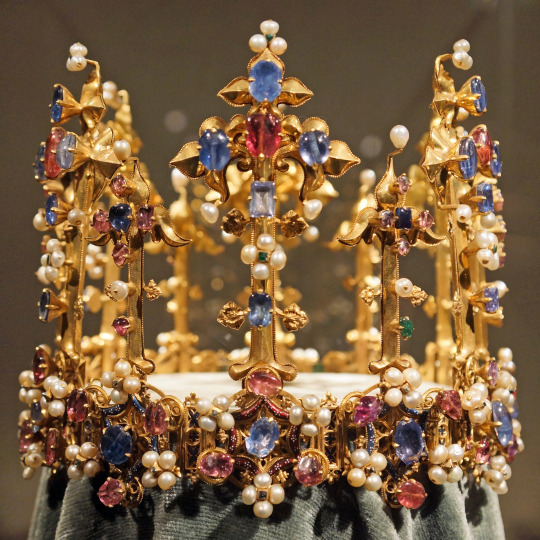
The Palatine Crown or Bohemian Crown, is the oldest surviving royal crown known to have been in England, and probably dates to the years after 1370. The nuptial crown is first documented in the inventory of King Richard II of England
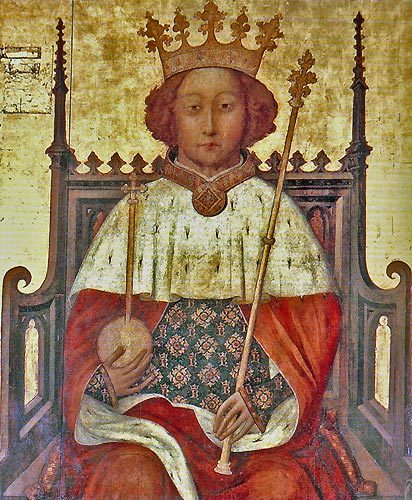
as having 12 fleurons, but a rosette was missing. At the time, it was decorated with 91 pearls, 63 balas rubies, 47 sapphires, 33 diamonds, and 5 emeralds. An additional 7 pearls and 1 emerald had been taken off the fleurons. The crown weighed 5 marks 7 oz, or just under 1 kilogram, and was valued at £246 13s 4d.

altmarius
The crown came to the Palatine line of the House of Wittelsbach
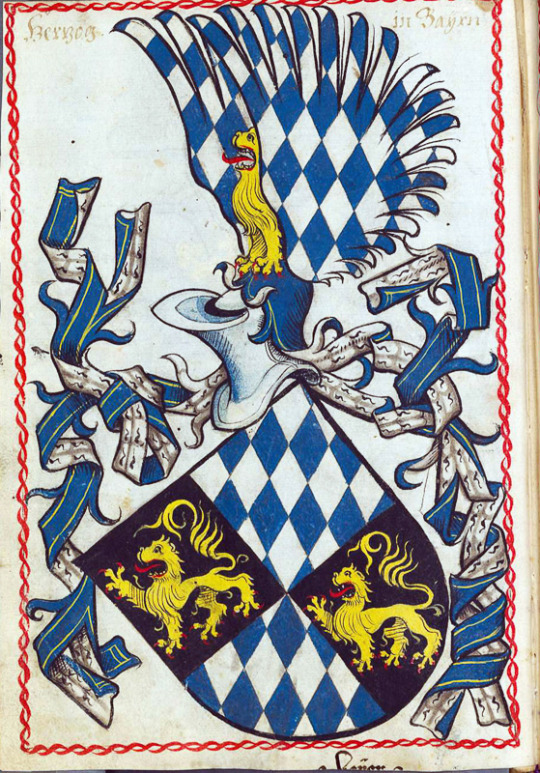
as dowry of Blanche of England, daughter of King Henry IV of England. After his accession to the English throne, Henry wanted to make important alliances in order to maintain and legitimise his rule. One ally whose support he hoped to gain was the Wittelsbach King Rupert of Germany, who also took the German throne after the deposition of King Wenceslaus. A marriage between Rupert’s eldest surviving son, Louis, and Henry IV’s eldest daughter, Blanche, was soon arranged.

On 7 March 1401, the marriage contract was signed in London, and the bride’s dowry was fixed at 40,000 nobles. In 1402, prior to the wedding of Blanche and Louis III, it was restored by a London goldsmith, who added a twelfth rosette and replaced the missing emerald and pearls on the fleurons. The new rosette contained 12 pearls, 3 diamonds, 3 balas rubies, and 1 sapphire. In total, 1 6⁄8 ounces (50 g) of gold were added to the crown. Blanche wore the crown at her wedding, which took place on 6 July 1402 at Cologne Cathedral in Germany.

In 1421, it was pawned to Maulbronn Monastery, and by that time several gems and pearls had been taken out. Since 1782, the crown is displayed in the treasury of the Munich Treasury with other jewels belonging to the Palatine branch of the Wittelsbach family. In 1988, the crown featured in the Age of Chivalry exhibition at the Royal Academy of Arts in London – the first time it had returned to England since 1401.

wikiwand
Made of gold with enamel, sapphires, rubies, emeralds, diamonds, and pearls. The crown came to the Palatinate line of the House of Wittelsbach in 1402 as a dowry of Princess Blanche of England, a daughter of King Henry IV of England, on her marriage to Louis III, Elector Palatine. After the junior Bavarian branch of the house became extinct in the male line in 1777, the senior Palatine branch replaced the former as the country’s rulers. It has been described as “one of the finest achievements of the Gothic goldsmith.
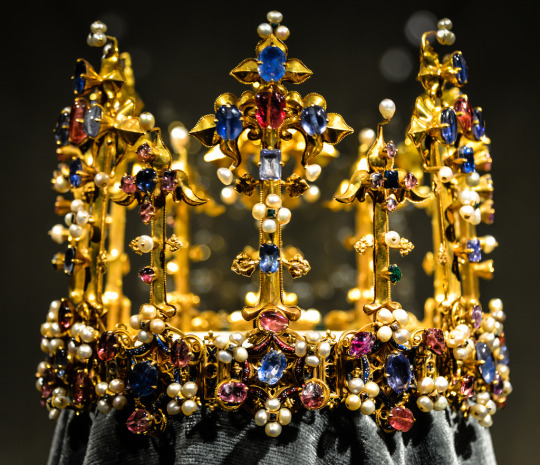
It is not thought that the crown was made for Blanche because it was first recorded in a list of 1399, recording the movement of some royal jewels in London, some two years before the marriage of Princess Blanche. Experts believe that the crown probably belonged to King Edward III or Queen Anne of Bohemia, the wife of King Richard II, whom she married in 1382.

flickr
In 1402, Princess Blanche, the daughter of King Henry IV of England, married the Palatine Elector Ludwig III and the crown passed to the Palatine Treasury in Heidelberg as part of her dowry.
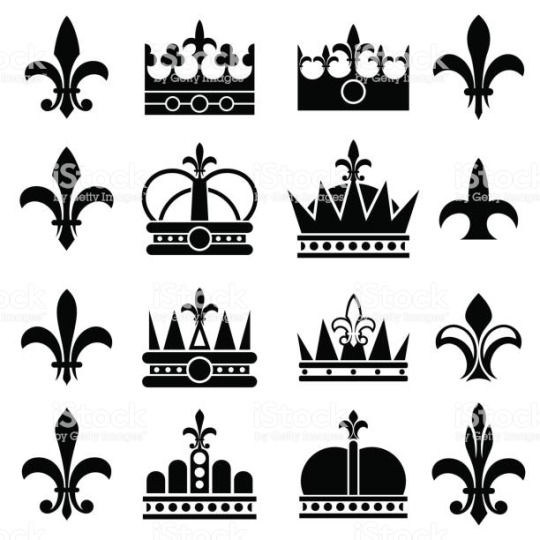
free vector
The crown is made up of 12 hexagonal rosettes on the base each supporting a gold stem topped by a lily. The stems and lilies alternate in size and height. They are heavily jewelled versions of the fleur de lys (lily flower) that was popular for medieval crowns. In the middle of the hexagons, which have enamelled white flowers overlaid onto a translucent blue or red background, is a pale blue sapphire, 11 of which are oval and 1 is hexagonal. Each point is decorated with alternating rubies and clusters of four pearls that have a small diamond at the centre. In addition to diamonds, pearls, and sapphires, the lilies are also decorated with emeralds.

Some of the original pearls may have been replaced when the crown was restored in 1925. The lily stems are detachable, and it is possible to fold the crown’s base so that it can be transported more easily. Each rosette is numbered 1–12 to make sure the lilies are re-attached correctly. The crown is 18 centimetres (7.1 in) in both height and diameter. The lily stems are detachable, and the places on the crown where they fit are numbered I to XII so they can be re-attached correctly. Its height and diameter are both 18 cm.
source https://en.wikipedia.org/wiki/Crown_of_Princess_Blanche/
Wonderful! Thank you😊❤️❤️❤️❤️
47 notes
·
View notes
Text
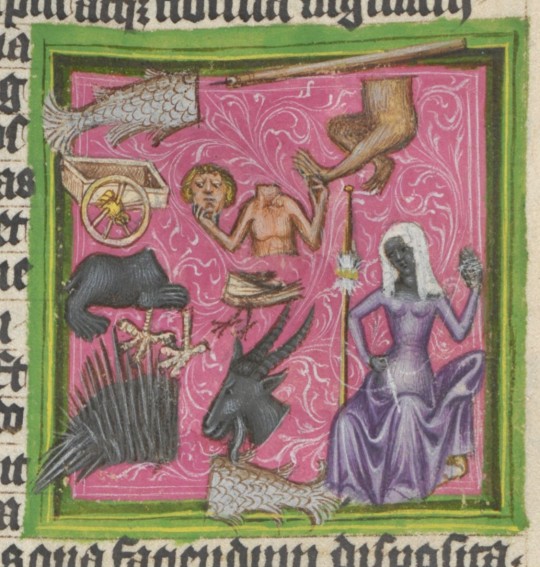

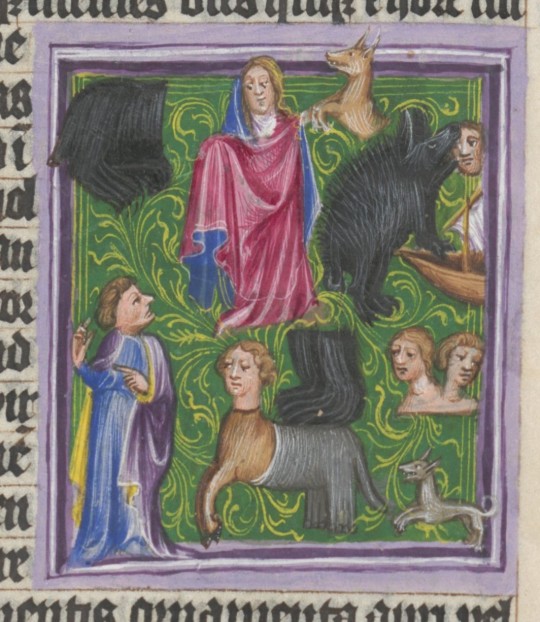
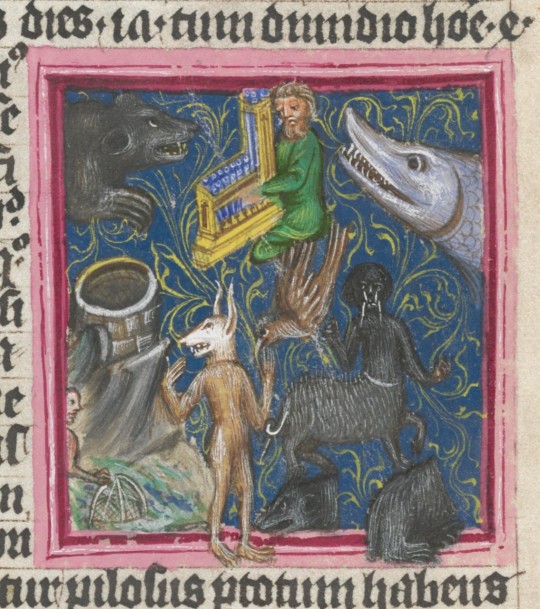
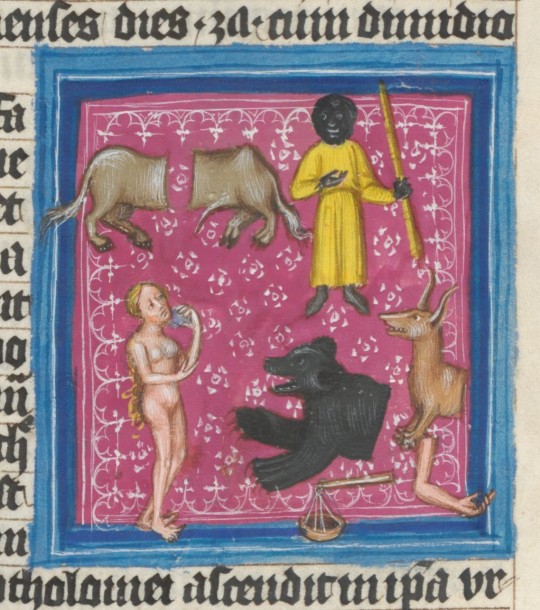
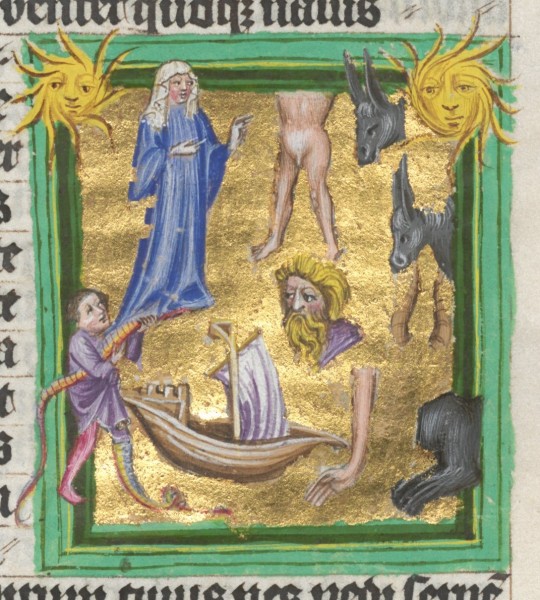
astronomical illustrations
from an astronomical-astrological codex for king wenceslaus iv. of bohemia, prague, shortly after 1400
source: Munich, BSB, Clm 826, fol. 13v-25v
#15th century#astrology#astronomy#constellations#zodiac signs#wenceslaus iv. of bohemia#hybrids#medieval poc#fragments#medieval art
454 notes
·
View notes
Photo



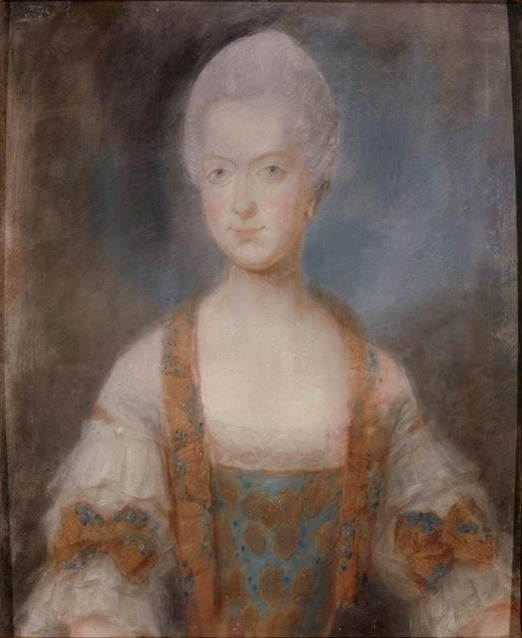





Royal Birthdays for today, February 26th:
Wenceslaus IV, King of Bohemia, 1361
Christopher of Bavaria, King of Denmark/Sweden/Norway, 1415
Albert VI, Duke of Bavaria, 1584
Maria Amalia of Austria, Duchess of Parma, 1746
Ferdinand I, Tsar of Bulgaria, 1861
Talal I bin Abdullah, King of Jordan, 1909
Ernst August V, Prince of Hanover, 1954
Chakriwat Mahidol, Prince of Thailand, 1983
Mahra bint Mohammed Al Maktoum, Princess of Dubai, 1994
#maria amalia of austria#albert vi#christopher of bavaria#Wenceslaus IV#ferdinand i#Talal I bin Abdullah#Ernst August V#Chakriwat Mahidol#Mahra bint Mohammed Al Maktoum#long live the queue#royal birthdays
30 notes
·
View notes
Text
Events 9.28 (before 1940)
48 BC – Pompey disembarks at Pelusium upon arriving in Egypt, whereupon he is assassinated by order of King Ptolemy XIII.
235 – Pope Pontian resigns. He is exiled to the mines of Sardinia, along with Hippolytus of Rome.
351 – Constantius II defeats the usurper Magnentius.
365 – Roman usurper Procopius bribes two legions passing by Constantinople, and proclaims himself emperor.
935 – Duke Wenceslaus I of Bohemia is murdered by a group of nobles led by his brother Boleslaus I, who succeeds him.
995 – Boleslaus II, Duke of Bohemia, kills most members of the rival Slavník dynasty.
1066 – William the Conqueror lands in England, beginning the Norman conquest.
1106 – King Henry I of England defeats his brother Robert Curthose at the Battle of Tinchebray.
1238 – King James I of Aragon conquers Valencia from the Moors. Shortly thereafter, he proclaims himself king of Valencia.
1322 – Louis IV, Holy Roman Emperor, defeats Frederick I of Austria in the Battle of Mühldorf.
1538 – Ottoman–Venetian War: The Ottoman Navy scores a decisive victory over a Holy League fleet in the Battle of Preveza.
1542 – Juan Rodríguez Cabrillo of Portugal arrives at what is now San Diego, California. He is the first European in California.
1779 – American Revolution: Samuel Huntington is elected President of the Continental Congress, succeeding John Jay.
1781 – American Revolution: French and American forces backed by a French fleet begin the siege of Yorktown.
1787 – The Congress of the Confederation votes to send the newly written United States Constitution to the state legislatures for approval.
1821 – The Declaration of Independence of the Mexican Empire is drafted. It will be made public on 13 October.
1844 – Oscar I of Sweden–Norway is crowned king of Sweden.
1867 – Toronto becomes the capital of Ontario, having also been the capital of Ontario's predecessors since 1796.
1868 – The Battle of Alcolea causes Queen Isabella II of Spain to flee to France.
1871 – The Brazilian Parliament passes a law that frees all children thereafter born to slaves, and all government-owned slaves.
1889 – The General Conference on Weights and Measures (CGPM) defines the length of a metre.
1892 – The first night game for American football takes place in a contest between Wyoming Seminary and Mansfield State Normal.
1893 – Foundation of the Portuguese football club FC Porto.
1901 – Philippine–American War: Filipino guerrillas kill more than forty American soldiers while losing 28 of their own.
1912 – The Ulster Covenant is signed by some 500,000 Ulster Protestant Unionists in opposition to the Third Irish Home Rule Bill.
1912 – Corporal Frank S. Scott of the United States Army becomes the first enlisted man to die in an airplane crash.
1918 – World War I: The Fifth Battle of Ypres begins.
1919 – Race riots begin in Omaha, Nebraska.
1924 – The first aerial circumnavigation is completed by a team from the US Army.
1928 – Alexander Fleming notices a bacteria-killing mold growing in his laboratory, discovering what later became known as penicillin.
1939 – World War II: Nazi Germany and the Soviet Union agree on a division of Poland.
1939 – World War II: The siege of Warsaw comes to an end.
0 notes
Photo
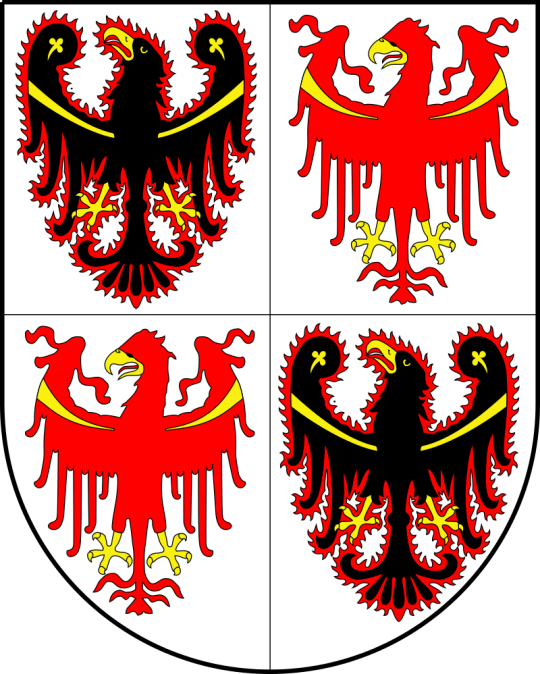
Arms of Trentino-Alto Adige, Italy
Granted 1972
Blazon: Argent per quarterly I and IV an eagle displayed sable armed or enflamed gules, II and III an eagle displayed gules armed or
The eagle in the first and third quarters is one we’ve touched on before - the flaming eagle of the Přemyslid dynasty. The eagle also became known as a symbol of St. Wenceslaus (since he was also a member of the dynasty). The Přemyslids died out in 1306, and in 1339, the king of Bohemia permitted the prince-bishopric of Trent to use their arms. This later evolved into the province of Trentino, which was incorporated into the region. Similarly, the red eagle has been the symbol of the region of Tyrol since 1205. Tyrol is currently split between North Tyrol and South Tyrol; the latter forms the province of Bolzano - Alto Adige, which is the other part of the region.
16 notes
·
View notes
Text
BanG Dream! and its Saints - Roselia
I am back for more of this series, this time it’s the girls from Roselia!

October 26 - Yukina Minato
St. Fulk of Pavia: Italian Roman Catholic prelate who served as the Bishop of Piacenza from 1210 until 1217 and later as the Bishop of Pavia from 1217 until his death. Fulk served in various capacities prior to his episcopal appointment such as a canon and provost, and was known for making the effort of keeping out of political affairs since he wanted to dedicate himself more to diocesan affairs. Pope Gregory IX canonized him as a saint during his pontificate; his remains were transferred from the old to new cathedral in 1567.
March 20 - Sayo Hikawa
St. John Nepomucene (John of Nepomuk): 14th century priest and martyr who was drowned in the Vltava river at the behest of Wenceslaus IV of Bohemia (Czech Republic). Later accounts state that he was the confessor of the queen of Bohemia and refused to divulge the secrets of the confessional. On the basis of this account, John of Nepomuk is considered the first martyr of the Seal of the Confessional, a patron against defamation and, because of the manner of his death, a protector from floods and drowning. He is the patron saint of the Spanish Naval Infantry.
July 3 - Ako Udagawa
St. Thomas the Apostle: According to the New Testament, he is one of the twelve apostles of Jesus and is informally referred to as 'Doubting Thomas' because he doubted Jesus' resurrection when first told (only to be found in the Gospel of John), and followed later by his confession of faith on seeing Christ's wounded body with these words: 'My Lord and my God! (John 20:28)' Thomas is believed to have traveled outside the Roman Empire to preach the Gospel after Christ's ascension, travelling as far as Tamilakam which are the states of Tamil Nadu and Kerala in present-day India. After he receive the crown of martyrdom (in which his attribute is a spear), the reputed relics were enshrined as far as Mesopotamia in the 3rd century, and later moved to various places.
October 17 - Rinko Shirokane
St. Ignatius of Antioch: 2nd century theologian, bishop, martyr and one of the Church Fathers. A disciple of St. John, the apostle and evangelist, is known mainly from seven highly regarded letters that he wrote during a trip to Rome, as a prisoner condemned to be executed for his beliefs. He was apparently eager to counteract the teachings of two groups—the Judaizers, who did not accept the authority of the New Testament, and the docetists, who held that Christ's sufferings and death were apparent but not real. The letters have often been cited as a source of knowledge of the Christian church at the beginning of the 2nd century. During the persecution under Emperor Trajan's reign, Ignatius is bought to Rome and is sentenced to be devoured by lions, hence becomes one of his attributes in Christian art.
August 25 - Lisa Imai
St. Louis IX of France: 13th century confessor who is the only King of France to be canonized in the Catholic Church. His father is Louis VIII, the Lion, and his mother is Blanche of Castile, and Louis crowned as king at 12 years old. As an adult, he faced recurring conflicts with some of his realm's most powerful nobles, such as Hugh X of Lusignan and Peter of Dreux. Simultaneously, Henry III of England attempted to restore the Angevin continental possessions, but was promptly routed at the Battle of Taillebourg. Louis annexed several provinces, notably parts of Aquitaine, Maine and Provence. Louis' actions were inspired by Christian zeal and Catholic devotion. He was a just king: although he exacted what was due him, he had no wish to wrong anyone, from the lowest peasant to the richest vassal. Without awaiting the judgment of the Roman Catholic Church, the people considered Louis IX to be a saint and prayed at his tomb. Pope Boniface VIII canonized Louis IX, the only king of France to be numbered by the Roman Catholic Church among its saints, in 1297.
#random stuff#catholic#catholic saints#bang dream#roselia (bang dream)#yukina minato#sayo hikawa#ako udagawa#rinko shirokane#lisa imai
1 note
·
View note
Note
introit (i bet it’s going to be kafka), offertorium, pie jesu!
requiem asks | accepting.
intriot: if your muse could revive one person from the dead, who would it be and why?
Oh, it’s true that Ludmila wholeheartedly and genuinely adores Kafka… Sadly, she didn’t get to meet him while he was still alive and only began reading his works right after his death. If she could have the opportunity to meet him, I have no doubt that she’d go on a frenzied state and might even start reciting romantic poetry to him. However, as much as she greatly admires him, Ludmila probably wouldn’t want to revive Kafka.
Rather, I think she’d revive Wenceslaus I instead, the benevolent duke (king?) of Bohemia. She was quite young while she was with him, although Ludmila did remember him as a good person and ruler. It is unfortunate that he died so suddenly and so brutally; though if she were to see him again, Ludmila would like to at least give him her gratitude for being an influential mentor to her.
Of course, there’s many more people she’d like to see again. Charles IV the Holy Roman Emperor, Bedřich Smetana, Jan Neruda… But considering that she only has to choose one, then she’d most likely pick Wenceslaus I.
offertorium: what piece of art describes your muse?
This 1906 painting by František Dvořák. How the girl is in complete solitude with no one but the flowers and her book as her companion… The hand resting on her forehead… She looks deeply immersed into her reading and almost seems as if she doesn’t care about anything else but the world that the words have created for her! I think this painting perfectly describes Ludmila.
pie jesu: imagine someone asks your muse “what have you become?” write how they respond to that question.

“That’s quite an intrusive question to ask me.” Though, it isn’t always that Ludmila gets an inquiry such as this, so she decides to indulge herself to it.
“To put it vaguely, I’d say that I’ve become… more of myself. I’ve learned many things about myself from these past few years, as if I’m only beginning to get to know my soul and my thoughts and, dare I say it, my heart. We never truly stay as the same person as we were back then – isn’t that how the saying goes? But I wouldn’t call it change,” A thoughtful hum: “But rather an extension of ourselves. Layering the things that we learn about ourselves along the way.”
#PHEWWWW zoo wee mama this took too long....#thank u for sending the ask mala! *kiss emoji*#| headcanon.#| answered.#korphasia
1 note
·
View note